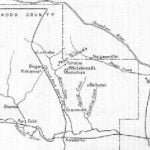
The remnants of the Caddo confederacies of northwestern Louisiana and northeastern Texas settled in Oklahoma in 1859. After the Louisiana Purchase when Louisiana bands joined their tribesmen in Texas all lived there peaceably until some White Texans determined upon an indiscriminate massacre of raiding Comanche and of all Reservation Indians.
The Caddo escaped by a forced march of two weeks in midsummer to the banks of the Washita River.
Of this period White Moon talked as follows:
Comanche and Kiowa would raid, up to the Caddo villages. 1 The Texans trailed them and blamed the Caddo as well. The soldiers stood by the Caddo, said they would move them north where they would have no further trouble with Texans. Caddo were scouts for the United States army.
Once a Kiowa wearing a corselet of hide from buffalo head and using medicine could not be killed. White soldiers shot at him, then a Caddo scout shot him in the back where the corselet raised up as he stooped. After the Caddo killed this fellow, the Kiowa became weak.
Before the Territory was opened up and afterwards, there were violent doings among both Whites and Indians. My jitney driver and friend, Jim Blakeley, who was a sheriff in those early days, told me several grim stories, but the story I found most interesting was told by James Ingkanish to illustrate the prophetic power of a Coyote.
Caiyute will tell you by his crying what is going to happen. My father was killed by outlaws in 1892. One time he was riding along and two caiyutes kep’ alongside, one on each side. They was crying. They would run ahead and sit down and wait until he caught up. Then they ran ahead again and sat down and cried. My father didn’ tell me about this until two weeks later. His mind was always on tracking them outlaws. I knew I had to get his mind off that. I would go along with him; when he saddled his horse I would saddle mine. At night he began to tell me what I should do for the family, if he wasn’t there. One day as I was ridin’ off to the sheep camp he gave me five dollars. He gave five to Henery (Gen. 111, 18) and five to Joe Dunlop (half brother to Nako’tete, Gen. III, 10). Them two, Dunlop and my father, was going deer hunting and then going to meet me at the sheep camp. Dunlop met me there but my father did not. Each had gone after a deer. Dunlop got his. Didn’t know what became of my father. Didn’t come home that night. When we got back to the house we saw some men coming up. I thought they was the outlaws. I gave guns to all the men in the house and said, “I am going out bare-handed; but if you see them draw a gun on me, shoot!” They was marshals after them outlaws.
We got out before daybreak to follow my father’s track, from where he had left Dunlop. Went down to creek; camp fire on other side. My father had gone down on opposite side of creek a little way and then turned. They must have called him back. Probably tied his legs under his horse. We followed the tracks, one was riding each side father’s horse, one riding behind. Went to sunflower brush. Here marshals dropped back, thinking outlaws might be hiding in it to shoot, but I kept on. Found my father shot in forehead and under jaw. When they shot first he must have given a whoop, yelled, like a brave man, and then they shot again. Shot his horse too. I turned back. The marshals went on. Later, when they was hanging one of the outlaws, a man asked him what he was hanging for. “For killing Ingkanish.” Had nothing against him ‘cept for spy. They knew marshals were hot on them and he would tell on them.
Today the two centers of distribution of the people in the Wichita Reservation 2 in western Oklahoma are Sugar Creek (R., nawidi’chabitso’ : na, locative, widi’c, salt, habitso’ it is sweet) 3 in the north of Caddo County about fifteen miles north of Anadarko, and, in the south, Fort Cobb (nasŭ.nada’: na, locative, sŭ.nda’, soldier), along the Washita River from Fort Cobb to Anadarko (nawashita). According to White Moon’s estimate about 350 persons live in the northern division and about 150, in the southern. 4 This population lives scattered on the lands given to individuals at the allotment made by the Federal Government in 1902. Before the allotment-160 acres to every soul-there was a piece of tillable land, probably near Anadarko, which was worked by the tribe, a plot assigned to each household. This land was referred to as natuahaimaikoina or nanatuaimai, at big field. 5
Citations:
- Weko, village[↩]
- For Caddo, Wichita, and Delaware tribes.[↩]
- R.=Reichard. Her phonetic key is:
t=i in fit
ŭ=oo in book
a=a in but
e=a in met
a= a in father
u=a in mute
o =o in note
G=kg medial
D=td medial
c=sh[↩] - In 1904 the tribe numbered 535 (Handbook) and in 1910, “a little more than 500” (Harrington). The Office of Indian Affairs enumerates 708 for 1930, 967 for 1937, 1019 for 1939, and 1048 for 1940. Obviously the criterion for tribal membership has been changing.[↩]
- Probably this is a reference to the tribal or large scale work-party for clearing and ploughing (hoeing) lands held separately by householders, which prevailed into the eighteenth century. There was the same kind of work-party for house building (Hatcher, XXXI, 155, 156).[↩]
